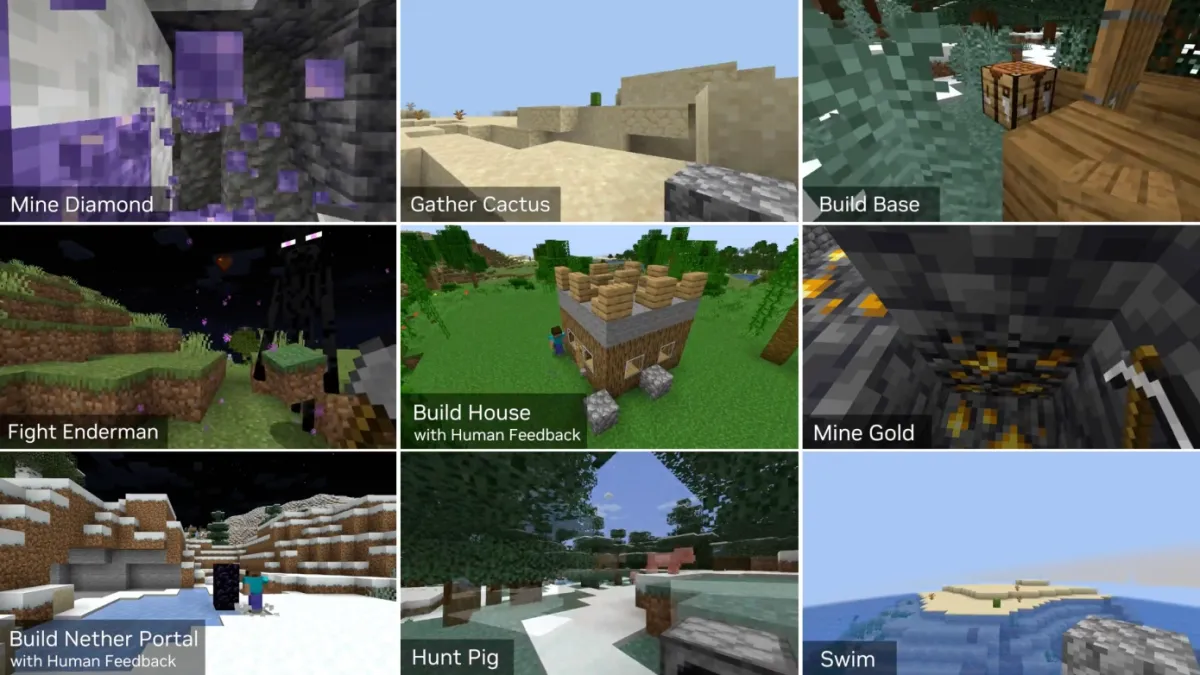To become a skilled Minecraft player, this AI utilized GPT-4

A new Minecraft bot has emerged that can learn and improve its skills in the game's open world by using GPT-4, a powerful text generator. A group of AI researchers created the bot known as Voyager, which uses GPT-4 to generate goals, code, and feedback. Unlike other bots that rely on predefined rules or human demonstrations, Voyager essentially writes its code through trial and error and many GPT-4 queries. It shows the potential of using language models to perform complex computer tasks.
Voyager is an experimental system that belongs to the field of embodied AI. Embodied AI is a branch of artificial intelligence that studies virtual or physical agents that can move, see, speak, and interact with their environment and other agents. Unlike chatbots and personal assistants, these agents must perform actual tasks or navigate complex environments.
Embodied AI has many applications, such as autonomous vehicles, robotics, and computer vision. Branch of artificial intelligence that studies virtual or physical agents that can move, see, speak, and interact with their environment and other agents. Unlike chatbots and personal assistants, these agents must perform fundamental tasks or navigate complex environments. Embodied AI has many applications, such as autonomous vehicles, robotics, and computer vision. Researchers are interested in how domestic robots can use embodied AI to perform specific tasks in the future.
Minecraft is a suitable environment for testing various concepts because it mimics the natural world in a simplified and flexible way with many possibilities to explore and experiment. However, it also has some limitations. For more precise and controlled simulations, specially designed tools are also helpful.
Since you can't just drop a random AI in there and expect it to understand what all these blocks and pigs are doing, MineDojo is a simulation framework created around Minecraft. For users to build or improve an AI model on them, its developers (who share many similarities with the Voyager team) compiled data such as transcripts from YouTube videos about the game, wiki articles, and a ton of Reddit posts from r/Minecraft. It also enables those models to be assessed more or less objectively by observing how well they perform tasks like enclosing a llama in a fence or discovering and mining diamonds.
The only other model that even comes close to matching Voyager's performance is the Auto-GPT. However, they both use GPT-4 to create their code as they go, which is a similar strategy.
Typically, you'd hope that by training a model on all the available Minecraft data, it would automatically learn to defend itself against skeletons when night falls. On the other hand, Voyager is relatively naive at the outset, and as it explores the game world, it has a short conversation with GPT-4 about what it should do and how it should do it.
Skeletons appear at night. The agent knows this, but it wonders: What would a good gamer do when monsters are nearby? GPT-4 suggests making and equipping a sword, then whacking the skeleton while avoiding it to explore the world safely. Collect stone and wood, build a sword at the crafting table, equip it, and fight a structure.
The system stores the skills it learns in a shared skill library. This way, it can reuse them for different tasks, such as "exploring a cave and collecting iron ore." It still relies on GPT but in a more efficient and faster version called GPT-3.5. This version helps it select the most relevant skills for a situation so it is clear from mining with fighting or vice versa.
Voyager is a specialized agency that can explore and learn from the Minecraft environment, which is much more complex and rich than the familiar interfaces that Auto-GPT can handle. Auto-GPT is an experimental application that uses GPT-4 to act autonomously by breaking down a goal into sub-tasks and using the internet and other tools in an automatic loop.
Auto-GPT is an experimental application that uses GPT-4 to act autonomously by breaking down a goal into sub-tasks and using the internet and other tools in an automatic loop. However, it needs help to cope with the challenges and opportunities that Minecraft offers, such as finding resources, learning skills, and navigating a large area. Voyager, on the other hand, excels at these tasks and outperforms other bots.
GPT-4 is a robust system that can generate code more efficiently than GPT-3.5 (i.e., ChatGPT). When replaced GPT-4 was with GPT-3.5 in a test, the latter struggled to produce valid code and did not improve over time. There is not much difference between the two models when they chat, but chatting does not require much intelligence. Coding is much more complex, and GPT-4 has made a giant leap.
Instead of replacing Minecraft players, this research aims to determine how to make straightforward AI models pick up on their "experiences" and use them to inform their future behaviour. Robots must be able to pick up new skills and adapt to new environments if we want them to assist us in our homes, hospitals, and workplaces.



